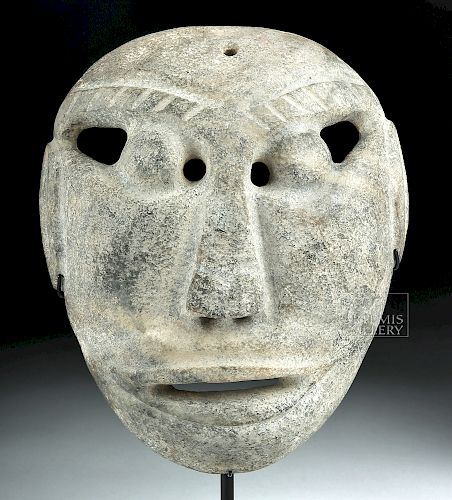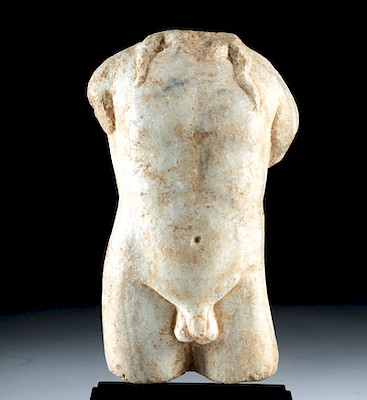Ancient Chinese Shang Dynasty Jade Mask (Nephrite)
Lot 91
About Seller
Artemis Fine Arts
686 S Taylor Ave, Ste 106
Louisville, CO 80027
United States
Selling antiquities, ancient and ethnographic art online since 1993, Artemis Gallery specializes in Classical Antiquities (Egyptian, Greek, Roman, Near Eastern), Asian, Pre-Columbian, African / Tribal / Oceanographic art. Our extensive inventory includes pottery, stone, metal, wood, glass and textil...Read more
Categories
Estimate:
$3,200 - $4,500
Absentee vs Live bid
Two ways to bid:
- Leave a max absentee bid and the platform will bid on your behalf up to your maximum bid during the live auction.
- Bid live during the auction and your bids will be submitted real-time to the auctioneer.
Bid Increments
| Price | Bid Increment |
|---|---|
| $0 | $25 |
| $300 | $50 |
| $1,000 | $100 |
| $2,000 | $250 |
| $5,000 | $500 |
| $10,000 | $1,000 |
| $20,000 | $2,500 |
| $50,000 | $5,000 |
| $100,000 | $10,000 |
| $200,000 | $20,000 |
About Auction
By Artemis Fine Arts
Dec 5, 2018
Set Reminder
2018-12-05 10:00:00
2018-12-05 10:00:00
America/New_York
Bidsquare
Bidsquare : DAY 1 | Classical Antiquities & Asian Art
https://www.bidsquare.com/auctions/artemis-gallery/day-1-classical-antiquities-asian-art-3698
Day 1 of an important 2-day auction featuring ancient and ethnographic art from around the world. Egyptian, Greek, Roman, Viking, Near Eastern plus Asian Art from China, Japan, Thailand, Vietnam, Burma, India, more. Artemis Fine Arts info@artemisgallery.com
Day 1 of an important 2-day auction featuring ancient and ethnographic art from around the world. Egyptian, Greek, Roman, Viking, Near Eastern plus Asian Art from China, Japan, Thailand, Vietnam, Burma, India, more. Artemis Fine Arts info@artemisgallery.com
- Lot Description
East Asia, China, Shang Dynasty, ca. 1558 to 1046 BCE. A large, impressive mask made from white jade (nephrite) with wide, staring eyes, a triangular nose, and a wide mouth with thick lips. Prominent cheekbones and large, incised eyebrows give the face a distinguished appearance. Two long ears are in low relief along the sides of the head. A drilled hole through the forehead was made for attachment - this item was likely sewn onto the burial garments of an elite member of Shang society. Jade carving had already been taking place for 2000 years in China by the time of the Shang, and possession of jade denoted wealth. Size: 6.45" W x 7.95" H (16.4 cm x 20.2 cm); 10.95" H (27.8 cm) on included custom stand.
Chinese art has incorporated jade since the Neolithic period; quarries for nephrite, the type of jade found in China, have been found in modern-day southern Mongolia that date to ca. 4000 BCE. The stone was prized for its hardness, its beautiful coloration (with a milky white being the most desired), and its durability. By the third millennium BCE, we know that jade had also come to be associated with immortality. Jade was used to make everything from everyday household objects and decoration to the ceremonial suits in which Han dynasty emperors were buried – with the belief that jade would preserve the body and the soul for eternity.
Provenance: private Newport Beach, California, USA collection
All items legal to buy/sell under U.S. Statute covering cultural patrimony Code 2600, CHAPTER 14, and are guaranteed to be as described or your money back.
A Certificate of Authenticity will accompany all winning bids.
We ship worldwide and handle all shipping in-house for your convenience.
#133516Encrusted patina on stone surface. Nice, vivid features and form.Condition
- Shipping Info
-
All shipping is handled in-house for your convenience. Your invoice from Artemis Gallery will include shipping calculation instructions. If in doubt, please inquire BEFORE bidding for estimated shipping costs for individual items.
-
- Buyer's Premium



 EUR
EUR CAD
CAD AUD
AUD GBP
GBP MXN
MXN HKD
HKD CNY
CNY MYR
MYR SEK
SEK SGD
SGD CHF
CHF THB
THB
















